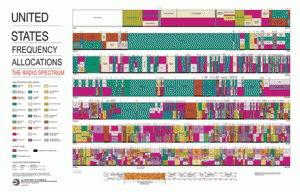In the face of a supposedly looming “spectrum crunch,” Congress and the President are endlessly threatening/promising to produce a conclusive compendium of where all the usable radio bands are presently located. I’m starting mine now for radio spectrum that is used in one way or another by radio stations—as opposed to TV, public safety responders, and so forth. When I say “radio,” I mean one-point-to-many audio that includes a live component; not person-to-person transmission.
This is a rough list. Feel free to add data, details, corrections, and as patriotic citizens we will submit the final draft to Capitol Hill.
The AM band, where here in San Francisco I can audit Rush Limbaugh or practice listening to Vietnamese, is located at 535-1605 kHz.
The FM band, where I am a subscriber in crabby standing to no less than three listener supported stations, occupies the 88 to 108 MHz zone.
HD Radio stations broadcast in conjunction with the above analog signals (correct me if I’m wrong about this or it is more complicated).
Then there’s that sneaky-pete low power TV channel 6, from which some stations also stream at 87.7 FM. As Paul Riismandel notes, that opportunity will sunset by 2015.
If you are a Sirius XM subscriber, its band allocation is from 2320 to 2345 MHz (or 2.320 to 2.345 GHz, if you insist). This is called the Digital Audio Radio Service.
If you are listening to a radio station via its website on your WiFi enabled computer, you are tuning into the station way up there at 2.4 GHz or 5 GHz.
If you are listening to a station via TuneIn radio on your mobile, well, you could be tuning in on quite a number of data frequencies. Go to Wireless Advisor, plug in your zip code, and it will give you the spectrum ranges for the major carriers.
There is also the Wireless Communications Service band (2305-2320 and 2345-2360 MHz), which hopefully by now is being deployed for broadband service (except the WCS carriers are in a huge fight with Sirius XM over interference, which the FCC has supposedly resolved but you never know . . . ).
And don’t forget about Digital Radio Mondiale, which Wikipedia says can stream at 4.5, 5, 9, 10, 18, 20, and 100 KHz.
Again, any additions and/or corrections to these assertions are very welcome. I’m particularly interested in which mobile bands are getting the most audio data use, given Verizon’s bid to sell off a chunk of that supposedly invaluable 700MHz spectrum it bought back in 2008.



